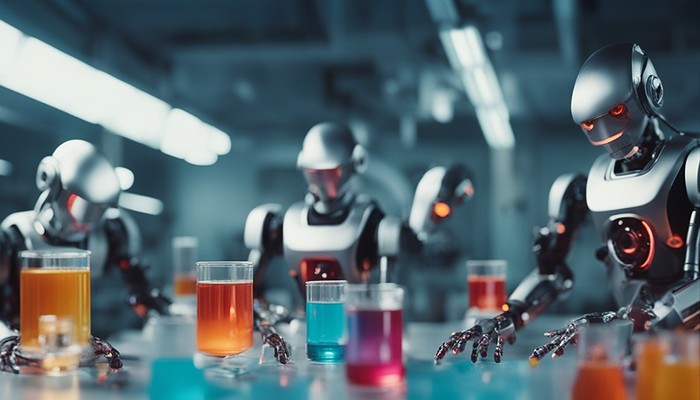In today's tech-savvy world, artificial intelligence is revolutionising various sectors, and the life sciences marketing arena is no exception. In this blog, we delve into ChatGPT and other large language models, examining their benefits, applications, and current limitations. Drawing on insights shared from Paul Avery, CEO of BioStrata and co-host of the podcast 'Artificially Intelligent Marketing,' we explore the scope and potential of these generative AI tools in life science marketing.
If you’re a visual learner, check out the 30-minute webinar version of this blog based on Paul Avery's recent SAMPS Europe 2023 talk. It offers deeper insights and expert commentary on the topics discussed in this blog post.
The evolution and impact of Generative AI in life science marketing
Generative AI is a subset of artificial intelligence technologies capable of creating new content, from text to images, without explicit human intervention. It comprises a suite of rapidly evolving tools that can produce diverse types of content—text, images, videos, computer code, speech, 3D models, or even music—from just a simple human prompt. Everything from generating background music for podcasts to creating realistic human portraits is now achievable through AI models trained on massive datasets. While early iterations of generative AI models had significant limitations, the outputs have become astoundingly more refined and useful over the past year or two.
Leading this rapid pace of change are companies like Anthropic, Google, Meta, and Microsoft, which are all pushing the boundaries of what's possible through their continued research and development in this space. In next to no time, we've gone from AI that could barely string a sentence together to models like ChatGPT that can engage in nuanced conversations across a wide range of topics. This tremendous progress sets the stage for expansive new possibilities for marketers across sectors. Understanding the rapid evolution of generative AI is key to unlocking its applications in life science marketing and beyond.
In the rest of this blog post, we’ll focus on using generative AI tools developed to produce text… this includes answering questions, writing content, brainstorming and any other output that takes the form of text (rather than images, music, video etc.). With this in mind, we next turn to perhaps the most famous AI tool for text generation, ChatGPT.
What is ChatGPT?
ChatGPT, or Chat Generative Pre-trained Transformer, is an advanced AI system developed by research company OpenAI. It utilises a neural network architecture called a “transformer” along with massive datasets to generate remarkably human-like text.
According to ChatGPT itself, it is a "powerful tool for life science marketing strategies." It can answer detailed questions, generate content on diverse topics, correct text, translate languages, write code, and much more. Its conversational nature and ability to provide context-relevant responses with a high degree of accuracy set ChatGPT apart from traditional search engines and the many other AI assistants.
However, when asked, ChatGPT also candidly explains its own limitations: As a language model without access to the internet or real-world knowledge, it can sometimes “generate plausible-sounding but incorrect information”. It advises users to “verify the accuracy of outputs whenever feasible”. Fact-checking and human oversight remain necessary, despite the impressive capabilities of AI chat tools like ChatGPT.
The intricacies behind ChatGPT: Why it works (and why it sometimes doesn't)
On a technical level, ChatGPT is not an all-knowing oracle but rather an extremely advanced predictive text generator. It has been trained on vast datasets comprising over a trillion words from digital books, forums, websites, and more. Based on an input prompt, ChatGPT predicts the most probable next word using complex mathematical models to build strings of words, sentences and paragraphs. This mechanism allows it to produce surprisingly coherent continuations from a given text prompt. However, a lack of real-world knowledge means ChatGPT at times generates logical but factually incorrect or nonsensical statements with unwarranted confidence. Its impressive fluency can disguise these potential inaccuracies.
Moreover, ChatGPT faces challenges with tasks requiring longer-term contextual understanding beyond the last few sentences. Remembering key details from much earlier in a conversation remains difficult. OpenAI is continuously working to enhance ChatGPT's capabilities to overcome these limitations, but a degree of circumspection is still prudent in utilising its outputs. In other words, always check what ChatGPT tells you to make sure it is sensible/correct.
Supercharging ChatGPT through plugins and integrations
While ChatGPT's built-in skills are formidable, its capabilities can be further augmented through the use of plugins and integrations tailored for specialised tasks. For instance, the SEO plugin helps optimise content for search engines by providing keyword and backlink recommendations.
There are also plugins that give ChatGPT access to real-time internet information, although these tend to slow down its typically fast response time. Some plugins are designed for very niche use cases, like helping compose music scores or automating data entry. Meanwhile, others make it possible to generate Canva images or interrogate the information within large PDF documents.
However, plugins can sometimes degrade ChatGPT's user experience, with slower response times and occasional glitchy behaviours. There are also valid concerns around data privacy and security with third-party plugins. So, while plugins unlock new possibilities, it's wise to evaluate whether the benefits outweigh the trade-offs based on your specific use case.
Diving deeper into leading AI language models beyond ChatGPT
While ChatGPT dominates many headlines, it represents just one approach to developing advanced AI systems for natural language understanding and generation. Researchers at companies like Microsoft, Google, Anthropic and others are actively pushing rival models with unique capabilities.
Getting to know the key differences allows marketers to make more informed choices based on their specific needs:
- Google Bard - Launched in 2022, Bard aims to combine the breadth of the internet and Google search with AI-powered language skills. Ask Bard a question, and it tries to provide a current, fact-checked answer by searching the web in real time. This makes it better suited for dynamic queries dependent on external data. However, the focus on speed and wide knowledge bases comes at the cost of depth of understanding in narrow domains. At the current time, Bard is worse at creating content than the other major models that are currently available. It also struggles at logical reasoning tasks when compared to ChatGPT (using the latest GPT 4.0 model).
- Microsoft Bing - Bing is based on OpenAI’s technology and also attempts to leverage web-scale data for more accurate, up-to-date outputs. Early demos focused on conversational search and using multiple information sources to provide verified responses. However, limitations persist in comprehending nuanced domain knowledge. While its writing abilities are better than Bard's, it still provides shorter, less well-written responses than ChatGPT 4.
- Anthropic Claude - Claude accepts lengthy contextual documents, with current models supporting up to 75,000 words as input. This allows Claude to deeply ingest domain information critical for precise responses, making the tool suitable for summarising complex reports or emails versus casual conversation. Anthropic recently upgraded the model behind the system to Claude 2.0, which provided the system with improved content generation and logical reasoning skills. While not quite as powerful as ChatGPT, Claude is probably its closest contender, while Claude’s context window of 75,000 words actually means it is better in some situations than ChatGPT (e.g. summarising long documents).
Rather than a one-size-fits-all solution, assess model strengths based on your specific workflows and content needs. Using multiple models can also provide cross-validation of the results that you get (which can be a handy way to check if the model you are using has, in fact, confidently produced inaccurate nonsense that you cannot trust). Many ChatGPT users routinely push all of their prompts through all of the models above, comparing and contrasting the outputs to select those elements that meet their needs from each model (and then combining them for use e.g. in a document, memo or email).
Using AI responsibly: The importance of human guidance
With all their capabilities, it’s tempting to let ChatGPT and its peers loose with minimal oversight. However, as these models continue to impress, we must be wary of becoming over-reliant on AI-generated outputs. While tools like ChatGPT can augment human capabilities, they lack true comprehension or judgment. The onus lies on us to verify accuracy, provide appropriate guidance, and retain control over final decisions rather than blindly trusting the machine.
A case in point was made when we ran an experiment where we used ChatGPT to summarise key discoveries about stem cells. The tool provided a compelling list of papers but included incorrect references, emphasising the need for human fact-checking of claims. Likewise, generating content at scale for SEO requires carefully evaluating the content for quality, rather than assuming AI-produced blogs will automatically drive traffic. As Uncle Ben from Spiderman says, “With great power comes great responsibility.” Keeping human oversight central allows us to reap the benefits of AI while minimising risks.
Applications of AI language models in life science marketing
Now that we’ve covered what Generative AI is and how some of today’s AI language models can be utilised by marketers for text generation, in this next section of the blog, we’ll explore some of the most promising applications of tools like ChatGPT, Bing, Claude and others in the realm of life science marketing.
Advanced search and research capabilities
AI language models like ChatGPT don't merely function as rudimentary search engines; they are more akin to research assistants with the added value of computational power. They not only provide search results but also lend contextual analysis to the information retrieved. This is particularly invaluable for professionals navigating through the labyrinthine world of biotechnology, genomics, pharmaceuticals, and other complex scientific disciplines. By offering insights that are grounded in context, these AI tools can help in decision-making processes. They are also adept at summarising large amounts of information (especially Claude, as mentioned earlier).
Streamlined content creation at scale
In the realm of life sciences marketing, the potential of AI for content creation is enormous. Language models like ChatGPT can generate an array of content, from academic articles and whitepapers to user-friendly FAQs and informative newsletters. They can also craft blog posts that explain complex scientific topics in layman's terms, as well as create social media posts that engage the audience effectively. Given the constant need for updated and accurate information in the life sciences sector, these models can produce content at a scale and speed that human writers would find challenging to match, thereby providing life sciences companies a distinct competitive advantage. However, as mentioned, “with great power comes great responsibility”, so be sure to check the outputs for accuracy. Most ChatGPT outputs also need finessing by an expert writer or editor to ensure they tell a compelling story in a credible way that makes sense to human readers.
Using AI for SEO at scale
While it's true that AI is making strides in automating SEO practices, it's important to proceed with caution. AI-generated content might be voluminous and keyword-rich, but search engines like Google are becoming increasingly sophisticated in identifying authentic, valuable content. That being said, AI can still play a pivotal role in achieving SEO goals. Specialised tools like SEO.app and Brain Work help in automating specific aspects like meta description writing and SEO-optimised content structuring. This allows life sciences marketers to focus on creating genuinely useful content while still adhering to SEO best practices, creating a balance that caters to both search engines and human readers.
AI tools for varied content types
AI's capability isn't confined to producing SEO-friendly blog posts; it extends to various forms of corporate communication. For instance, AI tools can generate precise and effective job descriptions that match the skill sets required for specialised roles in biotechnology or clinical research. Furthermore, AI can also assist in crafting business plans, project proposals, and internal memos. When it comes to emails, while current tools may sometimes struggle to get the tone exactly right, future advancements will allow you to train an AI agent on your specific writing style, improving their effectiveness significantly.
Content quality control and translation
Content quality is paramount in the life sciences sector, where even a minor mistake can leave a writer/brand with egg on their face. AI tools can serve as an extra layer of quality control, catching typographical and grammatical errors that human editors or other automated tools may overlook. Additionally, a newly emerging class of AI tools can provide accurate translations of even complex technical content across multiple languages. This could make it easier for companies seeking to expand their global footprint through local language translation, without losing the essence and integrity of their original content.
AI in sales and prospecting
Sales teams in life sciences can leverage AI for a wide variety of tasks. Tools are emerging that integrate seamlessly with Customer Relationship Management (CRM) systems like HubSpot, enabling not only efficient lead identification but also aiding in due diligence processes. These AI-based solutions can also auto-generate email drafts based on previous interactions and other CRM data, although manual review and customisation are often advised to maintain the personalised touch that is crucial in sales.
Creative campaign ideation
AI isn't just a tool; it can also be a collaborative partner in the creative process. For example, when brainstorming for a marketing campaign for a groundbreaking DNA sequencer, AI can rapidly generate a list of campaign ideas, taglines, or even potential challenges and solutions. This not only speeds up the ideation process but also introduces a diverse range of creative inputs that might not have been conceived through traditional brainstorming sessions.
Coding and debugging
While it may seem a bit far-fetched, AI is indeed making inroads into the coding world. It can assist in developing HTML, generating CSS styles, and even assist in debugging by pointing out potential errors or inefficiencies in the code. This can be especially helpful for life sciences companies that need to quickly implement or update web-based platforms for product launches, educational programs, or customer interactions.
Automation and custom outreach
Beyond content and creativity, AI also excels in the domain of automation. Imagine having to update complex product descriptions across multiple languages for thousands of products; AI can do this in a fraction of the time it would take a human. In terms of custom outreach, AI can help in segmenting audiences based on their behaviour, preferences, or engagement levels. It can then craft tailored messages or proposals, enhancing the effectiveness of outreach campaigns.
Embracing the future of AI in life science marketing
As we've journeyed through the fascinating world of AI-powered language models like ChatGPT, it's evident that their applications in life science marketing are as diverse as they are impactful. From enhancing research capabilities and streamlining content creation to automating tedious tasks and even contributing to creative brainstorming, these AI tools are undeniably revolutionising the marketing landscape.
However, it's crucial to recognise that while these AI models offer immense power, they come with their own set of challenges and limitations. Fact-checking, human oversight, and ethical considerations must go hand-in-hand with technological adoption to ensure responsible use. Remember, the tools are only as effective as the strategy behind them. Therefore, it's essential to align these cutting-edge technologies with your specific marketing goals to create a harmonious, efficient, and successful marketing ecosystem.
How to stay up to date with AI in life science marketing
The AI-driven future of life science marketing is no longer a far-off possibility—it is happening right here, right now. And in this ever-evolving landscape, staying updated and making informed choices can make all the difference between merely keeping pace and truly leading the charge.
To stay at the forefront of AI applications in life science marketing, you can subscribe to the "Artificially Intelligent Marketing" podcast co-hosted by Paul Avery and his industry friend, Martin Broadhurst. It's a helpful resource for real-world insights, case studies, and the latest trends in the intersecting worlds of AI and marketing. Don't miss out on staying updated in this fast-paced and exciting field.
If you're more of a visual learner, you can access a 30-minute recorded webinar version of this blog, based on Paul Avery's recent talk at SAMPS (Sales And Marketing Professionals in Science) Europe 2023. This webinar will allow you to delve deeper into the subject matter, enriched with Paul's firsthand experiences and expert commentary.
Finally, if you’d like help and support with embedding AI within your marketing team to increase efficiency, productivity and creativity, get in touch with our team to discuss the AI training and consultancy solutions that we offer.




